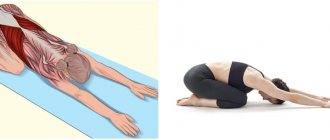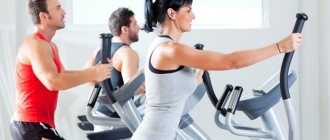Don't have the strength to go to the gym after work? No time and no place to do weight loss exercises at home? You can develop your own weight loss program for the office - and burn calories a little every day, fighting excess weight. The authors of the book “Working Without Extra Calories” tell you where to start and what weight loss exercises you can do at work.
Standing is healthier than sitting
Over the course of a couple of days, observe the following factors: first, calculate how many hours per day you sit in total, and second, find out how long each individual “sedentary period” is. The result may shock you, but that's for the best because the shock will push you to take action.
During the working day, when new tasks appear, you need to constantly ask yourself one important question: “Is it possible to do this on your feet?” And if the answer is yes, then do it. Moreover, the more often you repeat this question to yourself, the higher the likelihood that this thought will penetrate your subconscious and take effect.
One key is to pay attention to the duration of each "sedentary period." After every 20-30 minutes of sitting, plan to get up for 1-2 minutes and do a light stretch, then sit back down and get back to work.
A set of exercises for working out in the workplace
Active physical exercise or just exercise is, in most cases, an unaffordable luxury. Only the lucky owners of a separate office or free time can do them in the workplace. This is why knowing the basics of office gymnastics may come in handy. This is a comprehensive tool for training all muscles in the workplace, designed in such a way that all your actions are as invisible as possible to others. In other words, this is a kind of fitness for the office. In ordinary life, such exercises are used for warming up, but they can easily replace the main workout. The main thing is to correctly distribute the load and do everything as consistently as possible.
Such static complexes are also called isometric, as well as office yoga. In principle, this is not far from the truth, because they are all designed for full concentration, low speed and even breathing (as opposed to cardio exercise).
Exercises in the office on a chair
Most isometric exercises for the office are designed so that you can do them while sitting, that is, right at your workplace. You don't have to spend hours a day working every muscle in your body. Just make it a habit to do simple exercises for your abs, arm muscles or back several times a day. For example, half an hour before lunch, begin to actively suck in your stomach - this will help both remove your tummy and slightly reduce the volume of your stomach (which means you will eat a little less than usual). Have you worked for 2 hours without taking your eyes off the monitor? Stretch your neck and stretch your back thoroughly. Did something fall off the table? Lift it up by squatting nicely a few times. Thus, you will not need to allocate separate time for training at all - it will take place without interruption from your work process.
Losing weight in the office: what you can do while standing
When the phone rings , you just need to get up, even if the conversation is short. Calls - both short and long - accumulate throughout the day, and this total time can be subtracted from the sedentary period without regret.
If you go into standing mode day after day when the phone rings, you will eventually develop a reflex in which, upon hearing the telephone trill, your brain will order your body to stand up.
What should you do if your colleagues come over and plop down in their chairs to chat? If you are interested in lengthening your life, stand up as soon as they come to you . There are many benefits from such a simple action. Firstly, calories will immediately begin to be burned. Secondly, when guests see you standing, they are unlikely to sit down, so you can help them avoid the danger of sitting. Thirdly, your maneuver will hint to the guests that you are busy, and then they will moderate their ardor and talk only about the matter.
The same strategy should be applied to work meetings that you organize. It is worth scheduling a meeting in the farthest conference room so that you can walk a short distance to it - and take warm-up breaks every 20-30 minutes. Physically, it will help you burn a little more calories, but there are other benefits to taking breaks—business ones. When meeting participants stand up , they hit the reset button and typically return to the discussion with a fresh perspective on the issues at hand.
The practice of turning traditional meetings into stand-up or even walking meetings is already used in many companies, and there are many benefits to it. From a weight loss perspective, such meetings burn calories. In addition, a study conducted at Washington University in St. Louis found that meetings where people were standing increased work enthusiasm. When new ideas, problem solving, and brainstorming are required, walking meetings are the way to go.
Fitness in the office: simple exercises
Sedentary work is a difficult test for your figure and health. Your neck begins to hurt, your muscles become stiff, your legs become wooden, and your back becomes stone. Sound familiar? Even if work takes up most of your life, you can keep yourself in great shape and look your best. Read our article quickly - we will show you exercises that you can perform without leaving your office chair!
Start a set of lazy gymnastics exercises with circular rotations of your feet - 15-20 repetitions in each direction.
After warming up a little, start working on your neck: tilt your head forward so that your chin touches your chest, and then slowly and carefully tilt your head back. Is the back of your head touching your back? So everything is correct. Repeat 5 times.
Now start shoulder exercises: raise your shoulders as high as possible, try to touch your ears with them. Don't pull your head in! It turns out? Hold your shoulders in this position for about 5 seconds and then relax. Repeat the exercise 10 times.
Clasp your hands above your head and begin to perform smooth body turns all the way, first to the right, then to the left. 5-7 turns in each direction are enough to feel the spine relax.
To quickly see the desired six-pack abs and remove excess belly fat, regularly perform the following exercise: as you inhale, inflate your belly, and as you exit, pull it in so that it reaches your spine. Count to five in this position and relax your stomach. A few repetitions a day - and sculpted abs will no longer seem like an unattainable dream!
The ideal hip exercise is as simple as possible to perform. You just need to tightly squeeze the muscles of your buttocks and hold this position for 10-15 seconds. Repeat at any opportunity, because no one will notice such gymnastics!
The following technique will save you from numb legs: lifting and holding your leg in weight. Simply lift and straighten first one leg and then the other, holding each leg up for at least 10 seconds. Repeat 10-15 times. Every day, increase the hold time and the number of repetitions - your leg problems will disappear unnoticed.
If at work you don’t lift anything heavier than a computer mouse, it is especially important to pay attention to the muscles of your arms. Grab the armrests of your office chair, inhale and try to stand up using only your hands. Exhale and return to the starting position.
It will be difficult, but the effect is amazing! Three repetitions will be enough to start with. And advanced office athletes can perform this exercise ten times.
We complete the lazy workout with eye exercises. And it wouldn’t hurt to do this simple gymnastics every 2-3 hours.
Look left, right, up, down, but your face should not move! And then try to draw some numbers in the air with your eyes. Close them for half a minute and feel how your muscles relax and tone. Ready!
We train the muscles of the legs, buttocks and abs
Sitting on the same chair, rest your hands on the seat and, straining your abs, slowly lift your legs, slightly bent at the knees, parallel to the floor and hold them there for 3-4 seconds, then slowly lower them. Repeat the exercise 10-15 times. If it’s too easy for you, lower your legs without touching the floor, then start lifting again. You can also diversify the exercise by lifting your legs alternately.
And, of course, don't forget that isometric exercises for the lower body (that is, those in which the muscles tense, but no movement occurs) are simply designed for office fitness.
Isometric abdominal exercises: sitting at a table, while exhaling, slowly tighten your abdominal muscles as in a classic “twisting”, hold the tension in the muscles for 2-4 seconds, then relax (as you inhale).
Isometric exercises for the buttocks: in the same way, while sitting on a chair, squeeze (as you exhale) and relax (as you inhale) your gluteal muscles. Similar exercises can be repeated quite a large number of times (20-50).
Walk for 2 minutes every hour
It seems to you that you walk a lot at work, but usually such “walks” take no more than 20 seconds. Force yourself to walk for at least a minute to start (and then return to your starting point within the second minute). For what? A recent study from the Clinical Journal of the American Society of Nephrology found that walking every hour mitigated the negative effects of sitting for long periods of time.
#1 Stretch your spine
Sitting, feet on the floor hip-width apart, hands clasped behind the head and widely spaced at the elbows. Stretch your spine and look up at the ceiling, your arms taking the weight of your head. Return to the starting position.
With your hands at the back of your head, interlock your fingers, bring your elbows together, and gently stretch your spine to stretch the back of your neck. Repeat five times.
We develop joints and spine
Leg exercises: With your legs slightly bent under the table, make circular movements with your feet clockwise and then counterclockwise, alternately bending and straightening your knees. Do not strain your muscles; the purpose of this exercise, which can be repeated 3-4 times a day, is to improve lymph and blood circulation and prevent your legs from “stagnating.” It is especially useful for the prevention of varicose veins.
Spinal Twist: Sit sideways on the edge of a chair and place your hands on the back (the chair should not have wheels). Keeping your back straight, slowly turn your whole body towards the back (legs do not lift off the floor, feet parallel, shoulder-width apart, knees bent at right angles). Repeat the turn in the other direction (a total of 8-10 movements in each direction are enough).
Spinal bends: sit on the edge of a chair, knees bent at right angles, feet parallel, shoulder-width apart, grasp the back of the chair from behind on both sides (right and left hands, respectively), place your hands low enough, closer to the seat. Spread your shoulders and bend your back without straining, stay in this position for 4-5 seconds. Repeat the exercise 4-6 times. It is good to do it several times a day when you feel that your back is “tired”.










